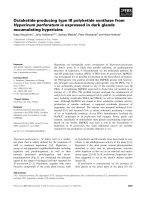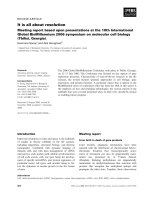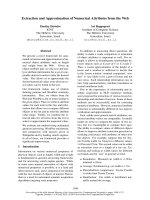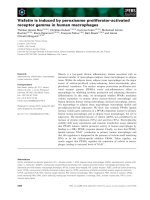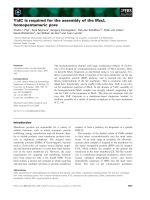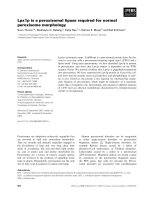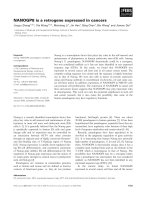Báo cáo khoa học: "Less is more: Eliminating index terms from subordinate clauses" pdf
Bạn đang xem bản rút gọn của tài liệu. Xem và tải ngay bản đầy đủ của tài liệu tại đây (564.65 KB, 8 trang )
Less is more:
Eliminating index terms from subordinate clauses
Simon H. Corston-Oliver and William B. Dolan
Microsoft Research
One Microsoft Way
Redmond WA 98052
{ simonco, billdol } @microsoft.com
Abstract
We perform a linguistic analysis of
documents during indexing for information
retrieval. By eliminating index terms that
occur only in subordinate clauses, index size
is reduced by approximately 30% without
adversely affecting precision or recall. These
results hold for two corpora: a sample of the
world wide web and an electronic
encyclopedia.
1 Introduction
Efforts to exploit natural language
processing (NLP) to aid information retrieval
(IR) have generally involved augmenting a
standard index of lexical terms with more
complex terms that reflect aspects of the
linguistic structure of the indexed text (Fagan
1988, Katz 1997, Arampatzis et al. 1998,
Strzalkowski et al. 1998, inter alia). This paper
shows that NLP can benefit information retrieval
in a very different way: rather than increasing
the size and complexity of an IR index,
linguistic information can make it possible to
store less information in the index. In particular,
we demonstrate that robust NLP technology
makes it possible to omit substantial portions of
a text from the index without dramatically
affecting precision or recall.
This research is motivated by insights from
Rhetorical Structure Theory (RST) (Mann &
Thompson 1986, 1988). An RST analysis is a
dependency analysis of the structure of a text,
whose leaf nodes are the propositions encoded in
clauses. In this structural analysis, some
propositions in the text, called "nuclei," are
more centrally important in realizing the writer's
communicative goals, while other propositions,
called "satellites," are less central in realizing
those goals, and instead provide additional
information about the nuclei in a manner
consistent with the discourse relation between
the nucleus and the satellite. This asymmetry has
an analogue in sentence structure: main clauses
tend to represent nuclei, while subordinate
clauses tend to represent satellites (Matthiessen
and Thompson 1988, Corston-Oliver 1998).
From the perspective of discourse analysis,
the task of information retrieval can be viewed
as attempting to identify the "aboutness," or
global topicality, of a document in order to
determine the relevance of the document as a
response to a user's query. Given an RST
analysis of a document, we would expect that for
the purposes of predicting document relevance,
information that occurs in nucleic propositions
ought to be more useful than information that
occurs in satellite propositions. To test this
expectation, we experimented with eliminating
from an IR index those terms that occurred in
certain kinds of subordinate clauses.
2 System description
At the core of the Microsoft English
Grammar (MEG), is a broad-coverage parser
that produces conventional phrase structure
analyses augmented with grammatical relations;
this parser is the basis for the grammar checker
in Microsoft Word (Heidorn 1999). Syntactic
analyses undergo further processing in order to
derive logical forms (LFs), which are graph
structures that describe labeled dependencies
among content words in the original input. LFs
normalize certain syntactic alternations (e.g.
active/passive) and resolve both intrasentential
anaphora and long-distance dependencies.
Over the past two years we have been
exploring the use of MEG LFs as a means of
349
improving IR precision. This work, which is
embodied in a natural language query feature in
the Microsoft Encarta 99 encyclopedia,
augments a traditional keyword document index
with a second index that contains linguistically-
informed terms. Two types of terms are stored in
this linguistic index:
1. LF triples. These are subgraphs
extracted from the LF. Each triple has the
form wordl-relation-word2, describing a
dependency relation between two content
words. For example, for the sentence
Abraham Lincoln, the president, was
assassinated by John Wilkes Booth, we
extract the following LF triples: t
assassinate LSubj John_Wilkes_Booth
assassinate LOb j Abraham_Lincoln
Abraham_Lincoln Equiv president
2. Subject terms. These are terms that
indicate which words served as the
grammatical head of a surface syntactic
subject in the document, for example:
Subject: Abraham_Lincoln
This linguistic index is used to postfilter the
output of a conventional statistical search
algorithm. An input natural language query is
first submitted to the statistical search algorithm
as a set of content words, resulting in a ranked
set of documents. This ranked set is then re-
ranked by attempting to find overlap between
the set of linguistic terms stored for each of
these documents and corresponding linguistic
terms determined by processing the query in
MEG. Documents that contain linguistic
matches are heuristically ranked according to the
nature of the match. Documents that fail to
match do not receive a rank, and are typically
not displayed to the user. The process of
building a secondary linguistic index and
matching terms from the query is referred to as
natural language matching (NLM) in the
discussion below. NLM has been used to filter
documents retrieved by several different search
technologies operating on different genres of
text.
Since NLM was intended for use in
consumer products, it was important to
minimize index size. We needed an algorithm
that would enable us to achieve reductions in
index size without adversely affecting precision
and recall. At the time when we were conducting
these experiments, there did not exist any
sufficiently large publicly available corpora of
questions and relevant documents for the two
genres of interest to us: the word wide web and
encyclopedia text. We therefore gathered queries
and documents for a web sample (section 3.2)
and Encarta 99 (section 3.3), and had non-
linguists perform double-blind evaluations of
relevance.
Three implementation-specific aspects of the
NLM index should be noted. First, in order to
limit index size, duplicate instances of a term
occurring in the same document are stored only
once. Second, because of the particular
compression scheme used to build the index, all
terms require the same number of bits for
storage, regardless of the length or number of
words they contain. Third, the top ten percent of
the NLM terms were suppressed, by analogy
with stop words in conventional indexing
schemes. Such high frequency terms tended not
to be good predictors of document relevance.
3 Experiments
We conducted experiments in which we
eliminated terms from the NLM index, and then
measured precision and recall. The experiments
were performed on two test corpora: web pages
returned by the Alta Vista search service
(section 3.2) and articles from the Encarta
electronic encyclopedia (section 3.3).
3.1 The kinds of subordinate clauses
In order to test the hypothesis that
information contained in subordinate clauses is
less useful for IR than matrix clause
information, we modified the indexing algorithm
so that it eliminated terms that occurred in
certain kinds of subordinate clauses. We
experimented with the following clause types:
I LSubj denotes a logical subject, LObj a logical
object and Equiv an equivalence relation.
350
Abbreviated Clause (ABBCL)
Until further indicated, lunch will be served
at 1 p.m.
Complement Clause
(COMPCL)
[ told the telemarketer that you weren't
home.
Adverbial Clause (ADVCL)
After John went home, he ate dinner.
Infinitival Clause (INFCL)
John decided to go home.
Relative Clause (RELCL)
I saw the man, who was wearing a green
ha__!.
Present Participial Clause
(PRPRTCL)
Napoleon attacked the fleet,
destroying it.
completely
In the experiments described below, terms
were eliminated from documents during
indexing. However, terms were never eliminated
from the queries.
3.2 Alta Vista experiments
We gathered 120 natural language queries
from colleagues for submission to Alta Vista. 2
The queries averaged 3.7 content words, with a
standard deviation of 1.7. 3 The following are
illustrative of the queries submitted:
Are there any air-conditioned hotels in Bali?
Has anyone ported Eliza to Win95?
What are the current weather conditions at
Steven' s Pass ?
What makes a cat purr?
Where is Xian ?
When will the next non-rerun showing of
Star Trek air?
2 Alta Vista's main search page
() encourages users to submit
natural language queries.
3 Words like "know" and "find", which are
common in natural language queries, are included in
these counts.
We examined the first thirty documents
returned by Alta Vista (or fewer documents for
queries that did not return at least thirty
documents). This document set comprised 3,440
documents. Since we were not able to determine
what percentage of the web Alta Vista accounted
for, it was not possible to calculate the recall of
this document set. In the discussion below, we
calculate recall as a percentage of the relevant
documents returned by Alta Vista. Precision and
recall are averaged across all queries submitted
to Alta Vista. The documents returned by Alta
Vista were indexed using NLM (section 2) and
filtered to retain only documents that contained
matches.
Table 1 contrasts the baseline NLM figures
(indexing based on terms in all clauses) with the
results of eliminating from the documents all
terms that occurred in subordinate clauses.
To measure the trade-off between precision
and recall, we calculated the F-measure (Van
Rij sbergen 1980), defined as
F - (f12 + 1.0)PR, where P is precision, R is
fl2p + R
recall and [3 is the relative weight assigned to
precision and recall (for these experiments,
13= 1).
As Table 1 shows, by eliminating terms
from all subordinate clauses in the documents,
the NLM index size was reduced by 31.4% with
only a minor impact (-0.82%) on F-measure.
Given unique indexing of terms per document,
and a constant size per term (section 2), we can
deduce that 31.4% of the terms in the NLM
index occurred only in subordinate clauses. Had
they occurred even once in a main clause, they
would not have been removed from the index.
We ran two comparison experiments. In the
first comparison, we deleted one third of all
terms as they were produced. Table 2 gives the
average results of three runs of this experiment.
In each run, a different set of one third of the
terms was deleted. Although fewer terms were
omitted
(28.8% 4 versus
31.4% when all terms in
4 TelTflS eliminated from a subordinate clause
in
one sentence might persist in the index if they
occurred in the main clause of another sentence in the
same document, hence a reduction of slightly less
than 33.3%.
351
subordinate clauses were eliminated) the
detrimental effect on F-measure was 5.3 times
greater than when terms occuring in subordinate
clauses were deleted.
Table 1 Alta Vista: Effects of eliminating subordinate clauses
Algorithm Precision Recall F % Change
in F 5
Baseline NLM 34.3 43.2 38.24 0.00
Subordinate clauses 35.9 40.2 37.93 -0.82
% Change in
index size
0.0
-31.4
Table 2 Alta Vista: Average effect of eliminating one third of terms
Precision Recall F % Change % Change in
in F index size
36.9 36.4 36.65 -4.34 -28.8
In the second comparison experiment, we
tested the converse of the operation described
in the discussion of Table 1 above: we
eliminated all search terms from the main
clauses of documents, leaving only search
terms that occurred in subordinate clauses.
Table 3 shows the dramatic effect of this
operation: as we expected, the index size was
greatly reduced (by 73.8%). However, F-
measure was seriously affected, by more than
two thirds, or -68.99%. The effect on F-
measure is primarily due to the severe impact
on recall, which fell from a tolerable baseline
of 43.2% to an unacceptable 7.5%. Comparing
the reduction in index size to the reduction
when subordinate clause information was
eliminated (73.8% versus 31.4%, a factor of
approximately 2:1) to the reduction in F-
measure (-68.99 versus -0.82, a factor of
approximately 84:1), it is clear that the impact
on F-measure from eliminating terms in main
clauses is disproportionate to the reduction in
index size.
Table 3 Alta Vista: Effect of diminating main clauses
Precision Recall F % Change % Change in
in F index size
28.3 7.5 11.86 -68.99 -73.8
Table 4 isolates the effects of deleting each
kind of subordinate clause. Most remarkable is
the fact that eliminating terms that only occur in
relative clauses (RELCL) yields a 7.3%
reduction in index size while actually improving
F-measure. Also worthy of special note is the
fact that two kinds of subordinate clauses can be
eliminated with no perceptible effect on F-
measure: eliminating complement clauses
(COMPCL), yields a reduction in index size of
7.4%, and eliminating present participial clauses
(PRPRTCL) yields a reduction in index size of
4.2%.
5 F is calculated from the underlying figures, to minimise the effects of rounding errors.
352
Table 4 Alta Vista: Effect of eliminating different kinds of subordinate clauses
Algorithm Precision Recall F % Change % Change in
in F index size
Baseline NLM 34.3 43.2 38.24 0.00 0.0
ADVCL 34.6 42.1 37.98 -0.67 -7.0
ABBCL ~ 34.3 43.2 38.24 0.00 -0.3
INFCL 34.8 42.1 38.10 -0.36 -11.8
RELCL 34.9 42.6 38.37 0.33 -7.3
COMPCL 34.5 42.9 38.24 0.00 -7.4
PRPRTCL 34.5 42.9 38.24 0.01 -4.2
Because of interactions among the different
clause types, the effects illustrated in Table 4 are
not additive. For example, an infinitival clause
(INFCL) may contain a noun phrase with an
embedded relative clause (RELCL). Elimination
of all terms in the infinitival clause would
therefore also lead to elimination of terms in the
relative clause.
3.3 Encarta experiments
We gathered 348 queries from middle-
school students for submission to Encarta, an
electronic encyclopedia. The queries averaged
3.4 content words, with a standard deviation of
1.4. The following are illustrative of the queries
submitted:
How many people live in Nebraska ?
How many valence electrons does sodium
have ?
I need to know where hyenas live.
In what event is Amy VanDyken the closest
to the world record in swimming ?
What color is a giraffe's tongue ?
What is the life-expectancy of an elephant?
We indexed the text of the Encarta articles,
approximately 33,000 files containing
approximately 576,000 sentences, using a
simple statistical indexing engine. We then
submitted each query and gathered the first
thirty ranked documents, for a total of 5,218
documents. We constructed an NLM index for
the documents returned and, in a second pass,
filtered documents using NLM. In the discussion
below, recall is calculated as a percentage of the
relevant documents that the statistical search
returned.
Table 5 compares the baseline NLM
accuracy (indexing all terms) to the accuracy of
eliminating terms that occurred in subordinate
clauses. The reduction in index size (29.0%) is
comparable to the reduction observed in the Alta
Vista experiment (31.4%). However, the effect
on F-measure of eliminating terms from
subordinate clauses is more marked (-4.91%)
than in the Alta Vista experiment (-0.82%).
Table 5 Encarta: Effects of eliminating subordinate clauses
Algorithm
Baseline NLM
Subordinate clauses
Precision
39.2
41.1
Recall
29.0
25.9
F
33.34
31.78
% Change % Change in
in F index size
0.00 0.0
-4.91 -29.0
The impact on F-measure is still
substantially less than the average of three runs
during which arbitrary non-overlapping thirds of
the terms were eliminated, as illustrated in
353
Table 6. This arbitrary deletion of terms results
in an 11.57% reduction in F-measure compared
to the baseline, approximately 2.4 times greater
than the impact of eliminating material
subordinate clauses.
in
Table 6 Encarta: Effects of eliminating one third of terms
Precision Recall F % Change % Change in
in F index size
40.2 23.8 29.88 - 11.57 -29.5
As Table 7 shows, eliminating terms from
main clauses and retaining information in
subordinate clauses has a profound effect on
recall for the Encarta corpus. As with the Alta
Vista experiment (section 3.2), it is instructive
to compare the results in Table 7 to the results
obtained when terms in subordinate clauses
were deleted (Table 5). Approximately 2.7
times as many terms were eliminated from the
index, yet the effect on F-measure is almost
thirteen times worse.
Table 7 Encarta: Effect of eliminating main clauses
Precision Recall
40.9 7.4
F % Change
in F
12.53 -62.41
% Change in
index size
-77.1
Table 8 isolates the effects for Encarta of
eliminating terms from each kind of subordinate
clause. It is interesting to compare the reduction
in index size and the relative change in F-
measure for Encarta, a relatively homogeneous
corpus of academic articles, to the
heterogeneous web sample of section 3.2. For
both corpora, eliminating terms that only occur
in abbreviated clauses (ABBCL) or present
participial clauses (PRPRTCL) results in modest
reductions in index size without negatively
affecting F-measure. Eliminating terms from
adverbial clauses (ADVCL) or infinitival clauses
(INFCL) also produces a similar effects on the
two corpora: a reduction in index size with a
modest (less than 1%) reduction in F-measure.
Relative clauses (RELCL) and complement
clauses (COMPCL), however, behave
differently across the two corpora. In both cases,
the effects on F-measure are positive for web
documents and negative for Encarta articles. The
negative impact of the elimination of material
from relative clauses in Encarta can perhaps be
attributed to the pervasive use of non-restrictive
relative clauses in the definitional encyclopedia
text, as illustrated by the underlined sections of
the following examples:
Sargon H (ruled 722-705 BC), who followed
Tiglath-pileser's successor, Shalmaneser V
(ruled 727-722 BC), to the throne, extended
Assyrian domination in all directions, from
southern Anatolia to the Persian Gulf
Amaral, Tarsila do (1886-1973), Brazilian
painter whose works were instrumental in the
development of modernist painting in Brazil.
After the so-called Boston Tea Party in 1773,
when Bostonians destroyed tea belonging to the
East India Company, Parliament enacted four
measures as an example to the other rebellious
colonies.
Another peculiar characteristic of the
Encarta corpus, namely the pervasive use of
354
complement taking nominal expressions such as
the belief that and the fact that,
possibly
explains the negative impact of the elimination
of complement clause material in Table 8.
Table 8 Encarta: Effect of eliminating different kinds of subordinate clauses
Algorithm Precision Recall F % Change % Change in
in F index size
Baseline NLM 39.2 29.0 33.34 0.00 0.0
ADVCL 39.9 28.4 33.18 -0.47 -5.8
ABBCL 39.6 29.0 33.48 0.43 -0.4
INFCL 40.0 28.3 33.15 -0.57 -9.2
RELCL 39.7 28.2 32.98 - 1.10 -9.5
COMPCL 38.9 28.3 32.76 - 1.75 -3.3
PRPRTCL 39.8 29.0 33.55 0.64 -5.5
4 Discussion
Although the results presented in section 3
are compelling, it may be possible to refine the
identification of clauses from which index terms
can be eliminated. In particular, complement
clauses subordinate to speech act verbs would
appear from failure analysis to warrant special
attention. For example, in the following sentence
our linguistic intuitions suggest that the content
of the complement clause is more informative
than the attribution to a speaker in the main
clause:
John said that the President would not
resign in disgrace.
Of course, more fine-grained
distinctions of this type can only be made given
sufficiently rich linguistic analyses as input.
Another compelling topic for future research
would be the impact of less sophisticated
analyses to identify various kinds of subordinate
clauses.
The terms eliminated in the experiments
presented in this paper were linguistic in nature.
However, we would expect similar results if
conventional word-based terms were eliminated
in similar fashion. In future research, we intend
to experiment with eliminating terms from a
conventional statistical engine, combining this
technique with the standard method of
eliminating high frequency index terms Rather
than eliminating terms from an index, it may
also prove fruitful to investigate weighting terms
according to the kind of clause in which they
occur.
5 Conclusions
We have demonstrated that, as implicitly
predicted by RST, index terms may be
eliminated from certain kinds of subordinate
clauses without substantially affecting precision
or recall. Rather than using NLP to generate
more index terms, we have found tremendous
gains from systematically eliminating terms. The
exact severity of the impact on precision and
recall that results from eliminating terms varies
by genre. In all cases, however, the systematic
elimination of subordinate clause material is
substantially better than arbitrary deletion of
index terms or the deletion of index terms that
occur only in main clauses.
Future research shall attempt to refine the
analysis of the kinds of subordinate clauses from
which index terms can be omitted, and to
integrate these findings with conventional
statistical IR algorithms.
Acknowledgements
Our thanks go to Lisa Braden-Harder, Susan
Dumais, Raman Chandrasekar, Eric Ringger,
Monica Corston-Oliver, Lucy Vanderwende and
the three anonymous reviewers for their help and
comments on an earlier draft of this paper and to
Jing Lou for assistance in configuring a test
environment.
355
References
Arampatzis, A. T., T. Tsoris, C. H. A. Koster, T. P.
Van Der Weide. (1998) "Phrase-based information
retrieval", Information Processing and
Management 34:693-707.
Corston-Oliver, S. H. (1998) Computing
Representations of the Structure of Written
Discourse. Ph.D. dissertation. University of
California, Santa Barbara.
Fagan, J. L. (1988) Experiments in Automatic Phrase
Indexing for Document Retrieval: A Comparison of
Syntactic and Non-syntactic Methods. Ph.D.
dissertation. Cornell University.
Heidorn, G. (1999) "Intelligent writing assistance."
To appear in Dale, R., H. Moisl and H. Somers
(eds.), A Handbook of Natural Language
Processing Techniques. Marcel Dekker.
Katz, B. (1997) "Annotating the World Wide Web
Using Natural Language." Proceedings of RIAO
97, Computer-assisted Information Search on
lnternet, McGill University, Quebec, Canada, 25-
27 June 1997. Vol. 1:136-155.
Mann, W. C. and Thompson, S. A. (1986)
"Relational Propositions in Discourse." Discourse
Processes 9:57-90.
Mann, W. C. and Thompson, S. A. (1988)
"Rhetorical Structure Theory: Toward a functional
theory of text organization." Text 8:243-281.
Matthiessen, C. and Thompson, S. A. (1988) "The
structure of discourse and 'subordination'." In
Haiman, J. and S. A. Thompson, (eds.). 1988.
Clause Combining in Grammar and Discourse.
John Benjamins: Amsterdam and Philadelphia.
275-329.
Strzalkowski, T. G. Stein, G. B. Wise, J. Perez-
Carball, P. Tapanainen, T. Jarvinent, A.
Voutilainen, J. Karlgren. (1997)Natural Language
Information Retrieval: TREC-7 Report.
Van Rijsbergen, C. J. (1980) Information Retrieval.
Butterworths: London and Boston.
356


